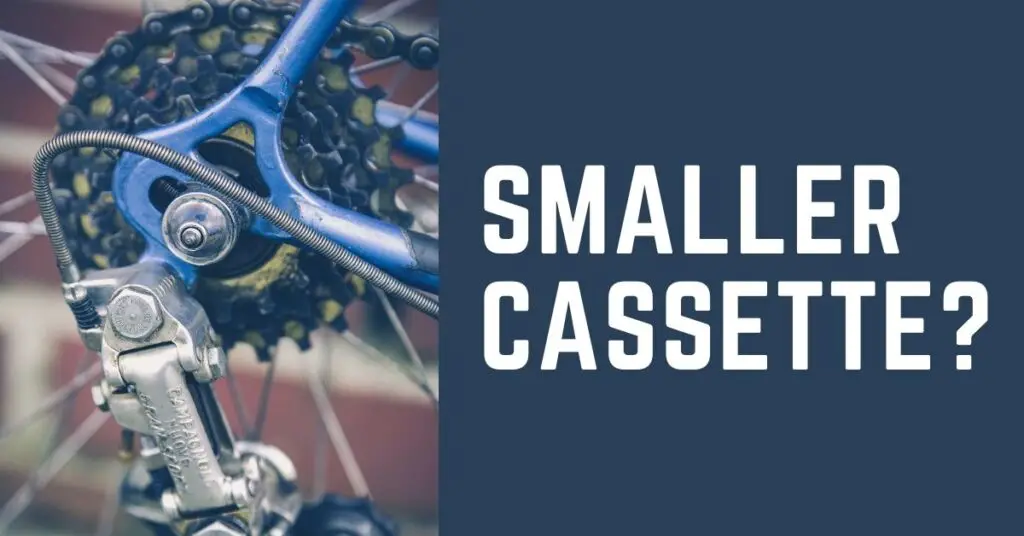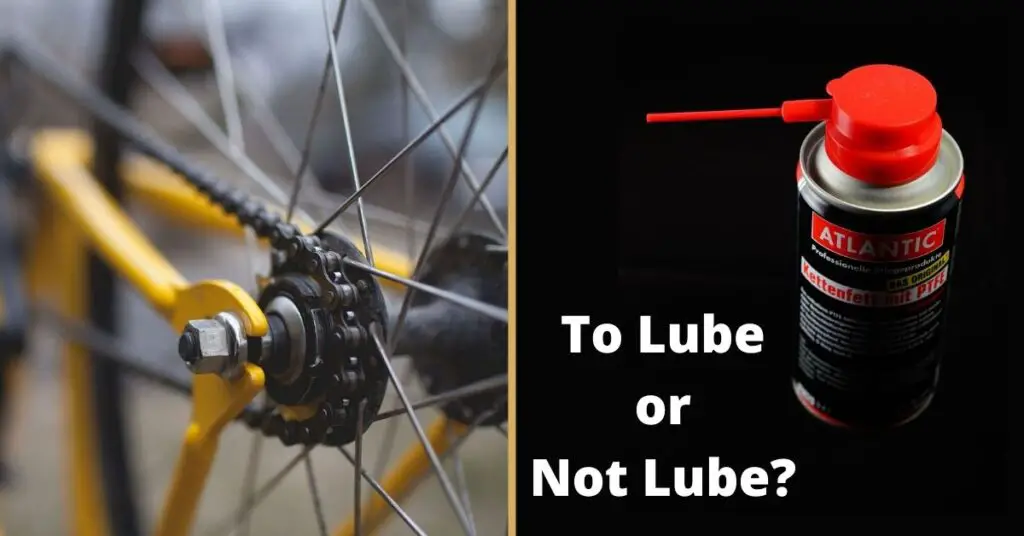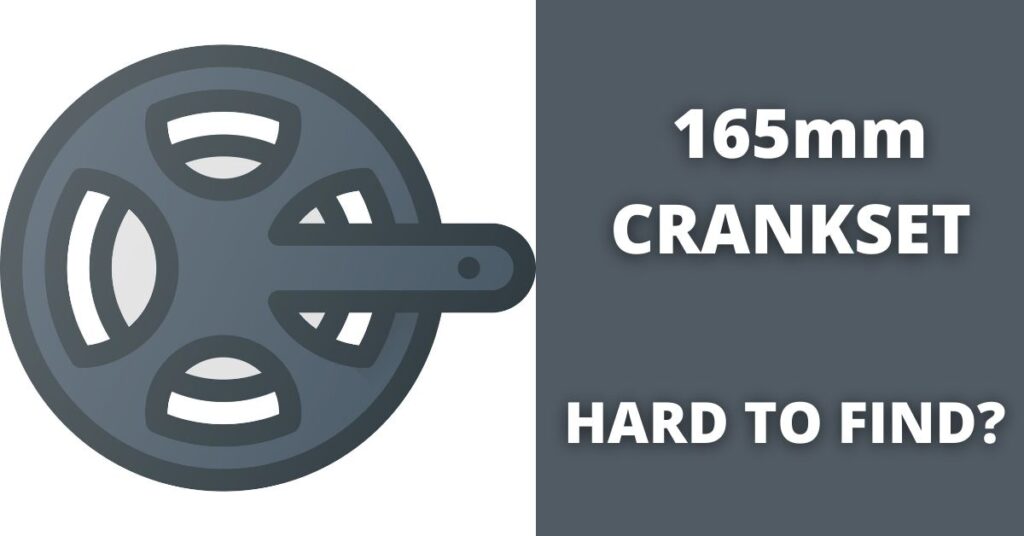Smaller cassettes are lighter and have tighter gear spacing which is why they are usually preferred and more commonly seen. There are also different sizes among smaller cassettes so it may be hard to choose the best one for your bike even when you know you need a smaller cassette.
We’ll be making this decision easier by explaining the different sizes and what benefits they each offer.
Can you put a smaller cassette on your bike? What does it require? Do you need to change other components to accommodate this? How much will it cost you? Let’s tackle all these in this article!

Can I Put a Smaller Cassette on My Bike?
Yes, you can. If a smaller cassette suits your needs and terrain more, there’s no reason why you can’t put it on your bike. It doesn’t affect the function of your bike or drivetrain in any way and shifting will not be different.
You may not even need to change or make adjustments to the existing components on your bike.
The only time you need to change your bike components is when the smaller cassette you want to put on your bike is of a different speed to what used to be there.
For example, if you were using a 10 speed larger bike cassette and you want to put a smaller cassette of 10 speed on your bike, you won’t need to change anything.
But if you want to put a smaller cassette of let’s say 7 or 8 speed you would have to change your derailleur, shifter.
What is a Bike Cassette?
The collection of cogs/sprockets on your freehub body is called a cassette. The cogs have teeth in varying numbers and are put on your freehub body in ascending order.
The cogs are made of metals and are circular and your cassette provides gearing options for you. Bikes have different numbers of cogs attached to their freehub body. The common ones are 8, 9, 10, and 11. They determine your bike speed.
Different Sizes of Cassettes
Cassettes come in different speeds and the speeds they come in tell us the number of cogs/ sprockets that make up that cassette. For example, a 9-speed cassette will be made up of 9 cogs and a 10-speed cassette will be made up of 10 cogs or sprockets.
You should note that these cogs will not be similar in size. A 10-speed cassette will have 10 cogs of varying sizes. It could be 11-32. This means the smallest cog has 11 teeth and the largest cog has 32 teeth. Two cassettes can both have 10 cogs and still have different sizes of cogs. This will make the two cassettes vary in size physically.
For example, a 10 speed 11-25 cassette will have these cog sizes;
11 – 12 – 13 – 14 – 15 – 17- 19 – 21 – 23 – 25T
And a 10-speed 11-32 cassette will have these cog sizes.
11 – 12 – 14 – 16 – 18 – 20 – 22 – 25 – 28 – 32T.
So even though these cassettes are both 10-speed cassettes, the second one will have a bigger size because its largest cog is bigger.
Benefits of a Smaller Cassette
A smaller cassette is one whose largest cog is about 25/ 26T downward. And there are lots of advantages to using them.
1- Less Weight
Lighter bikes usually perform better, especially when used by light riders. That’s why many riders find ways of reducing the weight of their bike.
One of the ways of doing this is by installing smaller cassettes.
Smaller cassettes use short cage derailleurs and shorter chains which will make a little difference in the weight of your bike.
2- Better Shifting
Smaller cassettes have a tighter gear ratio because there are fewer jumps between the sprockets. This makes shifting chains from sprocket to sprocket better and faster.
3- Better Chain Line
Because smaller cassettes have smaller jumps between gears, you can easily stay in the middle of your cassette as you have lots of options to choose there without jumps.
This improves your chain line and prevents cross chaining; prevents your chain from rubbing your front derailleur and chainrings.
Having smaller jumps also makes it easy to find the right gears for every situation while riding on flats.
Disadvantages of a Smaller Cassette
Smaller cassettes provide the necessary gearing to move fast on flats and are efficient for races they however cannot be used to climb.
To climb moderate hills, you will need cassettes with at least a 26 or 27T cog. For steeper hills, you will even need bigger cogs. You should choose a cassette with whose largest cog is at least 32T
Putting smaller cassettes on your bike will also require you to change some components. This can be costly and be an inconvenience.
Smaller Cassette Vs Bigger Cassette
1- Smaller cassettes have smaller jumps between gears so they are most suited for riders who ride on flat roads and riders who like to ride very fast.
Bigger cassettes on the other hand aren’t that suited for flat roads but they are best for climbing hills. With bigger cassettes, you’ll be able to maintain a high cadence while climbing steep hills and you won’t tire out.
Smaller cassettes can’t be used for that.
2- Bigger cassettes increase the weight of your bike because they are heavy, use long cage derailleurs and longer chains. Smaller cassettes on the other hand are light and use lighter drive trains.
3- Smaller cassettes shift better than bigger cassettes because they have tighter spaced gearing. This makes handling better and prevents your chain from early wear.
Do I Need a Shorter Chain for a Smaller Cassette?
Changing your bike chain when swapping cassettes Is best for drivetrain efficiency. Using an old chain with a new cassette wears out your cassette faster.
That being said if your chain is still new and you want to use it with the smaller cassettes you may or may not have to shorten it.
If the difference of the largest cog is not more than 2 teeth, shortening your chain isn’t necessary. For example, changing from an 11-30 to an 11-28 cassette.
If the difference is going to be 4 and above though, you should shorten your bike chain to remove slack. For example, changing from an 11-30 cassette to a 12-25 cassette.
How Much Does It Cost to Replace a Bike Cassette?
Bike cassettes cost between $20 and $500 depending on the size, type, and brand. If you’ll be doing it yourself you can save on labor costs but if you’ll be taking it to a repair shop, you’ll have to pay about $20 for labor.
Changing your chain while changing your cassette is also good unless you just started using the chain. A new chain costs between $15 and $30.
If you’re changing cassette sizes, you’ll even spend more. Depending on if you’re changing to a bigger or smaller cassette, you’ll need to buy a derailleur with a different cage length, and each cost between $20 and $30.
How Do I Know What Size Cassette to Get?
1- Terrain
The kind of road Ir condition you ride in determines the cassette size that is suitable for you. For flat terrain, smaller cassettes with 23T largest cog is enough.
For moderate climbing, you can get bigger cassettes than this, like a cassette with a 26 or 27T largest cog. For more steep climbs, you should get bigger ones.
Bigger cassettes are also better for rough roads.
2- Purpose
If you’re going to be using your bike to race, you don’t need bigger cassettes, unless you’re going to be racing uphill.
Smaller cassettes are also best for you if you commute or run errands around town with your bike.
For commuters and racers, quick shifting and easy peddling are needed and that’s what smaller cassettes offer.
Final Thoughts!
You can put smaller cassettes on your bike if you want. They are light, fast, and easy to shift.
The downside is you may have to spend a lot changing to a smaller cassette, depending on how big of a difference you are aiming for. You may need to shorten your chain or get a new one, buy a new derailleur and pay for labor.
Climbing is also impossible with them. So choosing smaller cassettes should be based on factors that affect your riding. Like where you ride and why you ride.
Bigger cassettes have numerous benefits too and you may find they are more suited to your needs after considering these factors.
In the course of the article, we have discussed cassette sizes in great detail so you can make an informed decision about the right size for you.
Cheers!




